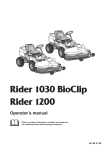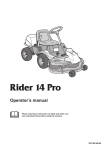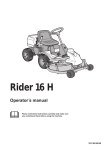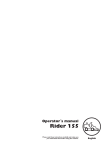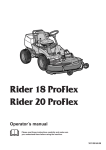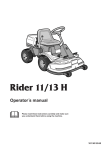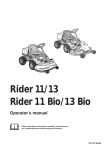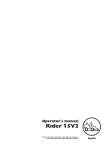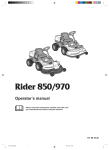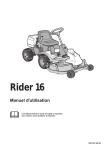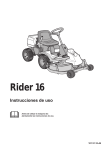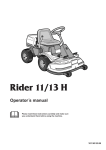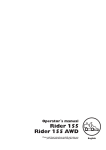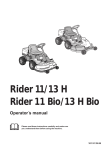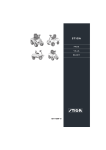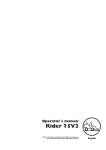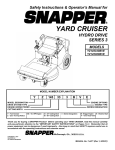Download Husqvarna Rider 16 User's Manual
Transcript
Rider 16 Operator´s manual Please read these instructions carefully and make sure you understand them before using the machine. 101 91 33-95 CONTENTS Operator’s Manual for Rider 16 Safety instructions .............................................. 3 General operation ............................................ 3 Slope operation ................................................ 3 Children ............................................................ 3 Service ............................................................. 4 Introduction ......................................................... 4 Driving and transport on public roads .............. 4 Towing .............................................................. 4 Use ................................................................... 4 Serial number ................................................... 5 Explanation of symbols ...................................... 6 Safety instructions .............................................. 7 General use ..................................................... 7 Driving on slopes ............................................. 8 Children ............................................................ 9 Maintenance .................................................... 9 Presentation ...................................................... 11 Location of the controls .................................. 11 Throttle/Choke lever ....................................... 12 Speed limiter .................................................. 12 Parking brake ................................................. 12 Cutting unit ..................................................... 13 Lift lever for cutting unit .................................. 13 Lever for adjustment of cutting height ............ 14 Seat ................................................................ 14 Fuelling .......................................................... 14 Driving ................................................................ 15 Before starting ................................................ 15 Starting the engine ......................................... 15 Driving the machine ....................................... 15 Cutting tips ..................................................... 18 Stopping the engine ....................................... 19 Release lever ................................................. 19 Maintenance ...................................................... 20 Maintenance schedule ................................... 20 Dismantling of the machine hoods ................. 21 Checking and adjusting the steering wires .... 22 Adjusting the brake ........................................ 22 Checking and adjustment of throttle wire ....... 23 Replacement of fuel filter ............................... 23 Replacement of air filter ................................. 24 Checking the fuel pump’s air filter .................. 25 Checking the battery acid level ...................... 25 Checking the safety system ........................... 26 Checking the tyre pressure ............................ 27 Checking the engine’s cooling air intake ........ 27 Fitting the cutting unit ..................................... 28 Installing BioClip 90 ....................................... 28 Checking and adjustment of cutting unit’s ground pressure ............................................. 29 Checking the parallelism of the cutting unit ... 29 Adjusting the parallelism of the cutting unit .... 30 Dismantling the cutting unit ............................ 30 Replacing the cutting unit belts ...................... 31 Service position for cutting unit ...................... 33 Checking the blades ...................................... 36 Replacing the break-pin (BioClip) .................. 37 Lubrication ......................................................... 38 Checking the engine’s oil level ....................... 38 Changing the oil ............................................. 38 Checking the transmission’s oil level ............. 39 Lubricating the belt adjuster ........................... 39 General lubrication ......................................... 39 Trouble shooting schedule .............................. 40 Storage ............................................................... 41 Winter storage ................................................ 41 Service ........................................................... 41 Technical data ................................................... 42 IMPORTANT INFORMATION Read through these instructions carefully so that you know how to use and maintain the machine before using it. For servicing other than described in this manual contact an authorised dealer for parts and service. English – 1 SAFETY INSTRUCTIONS These instructions are for your safety. Read them carefully. 1. Safety rules for USA Safe operation practices for ride-on mowers IMPORTANT! This cutting machine is capable of amputating hands and feet and throwing objects. Failure to observe the following safety instructions could result in serious injury or death. I. General operation 1. Read, understand and follow all instructions in the manual and on the machine before starting. 2. Only allow responsible adults, who are familiar with the instructions, to operate the machine. 3. Clear the area of objects such as rocks, toys, wire, etc., which could be picked up and thrown by the blade. 4. Be sure the area is clear of other people before mowing. Stop the machine if anyone enters the area. 5. Never carry passengers. 6. Do not mow in reverse unless absolutely necessary. Always look down and behind before and while backing. 7. Be aware of the mower discharge direction and do not point it at anyone. Do not operate the mower without either the entire grass catcher or the guard in place. 8. Slow down before turning. 9. Never leave a running machine unattended. Always turn off blades, set parking brake, stop engine and remove keys before dismounting. 10. Turn off blades when not mowing. 11. Stop engine before removing grass catcher or unclogging chute. 12. Mow only in daylight or good artificial light. 13. Do not operate the machine while under the influence of alcohol or drugs. 14. Watch for traffic when operating near or crossing roadways. 15. Use extra care when loading or unloading the machine into a trailer or truck. II. Slope operation Slopes are a major factor related to loss-of-control and tip-over accidents, which can result in severe injury or death. All slopes require extra caution. If you cannot back up the slope or if you feel uneasy on it, do not mow it. DO Mow up and down slopes, not across. Remove obstacles such as rocks, tree limbs, etc. 2 – English Watch for holes, ruts or bumps. Uneven terrain could overturn the machine. Tall grass can hide obstacles. Use slow speed. Choose a low gear so that you will not have to stop or shift while on the slope. Follow the manufacturer’s recommendations for wheel weights or counterweights to improve stability. Use extra care with grass catchers or other attachments. These can change the stability of the machine. Keep all movement on the slopes slow and gradual. Do not make sudden changes in speed or direction. Avoid starting or stopping on a slope. If tires lose traction, disengage the blades and proceed slowly straight down the slope. DO NOT Do not turn on slopes unless necessary and then, turn slowly and gradually downhill, if possible. Do not mow near drop-offs, ditches or embandments. The mower could suddenly turn over if a wheel is over the edge of a cliff or ditch, or if an edge caves in. Do not mow on wet grass. Reduced traction could cause sliding. Do not try to stabilize the machine by putting your foot on the ground. Do not use grass catcher on steep slopes. III. Children Tragic accidents can occur if the operator is not alert to the presence of children. Children are often attracted to the machine and the mowing activity. Never assume that children will remain where you last saw them. 1. Keep children out of the mowing area and under the watchful care of another responsible adult. 2. Be alert and turn machine off if children enter the area. 3. Before and when backing, look behind and down for small children. 4. Never carry children. They may fall off and be seriously injured or interfere with safe machine operation. SAFETY INSTRUCTIONS 5. Never allow children to operate the machine. 6. Use extra care when approaching blind corners, shrubs, trees or other objects that may obscure vision. IV. Service 1. Use extra care in handling gasoline and other fuels. They are flammable and vapours are explosive. a) Use only an approved container. b) Never remove gas cap or add fuel with the engine running. Allow engine to cool before refuelling. Do not smoke. c) Never refuel the machine indoors. Danger, keep hands and feet away d) Never store the machine or fuel container inside where there is an open flame, such as in a water heater. 2. Never run a machine inside a closed area. 3. Keep nuts and bolts, especially blade attachment bolts, tight and keep equipment in good condition. 4. Never tamper with safety devices. Check their proper operation regularly. 5. Keep machine free of grass, leaves or other debris build-up. Clean up oil or fuel spillage. Allow machine to cool before storing. 6. Stop and inspect the equipment if you strike an object. Repair, if necessary, before restarting. 7. Never make adjustments or repairs with the engine running. 8. Grass catcher components are subject to wear, damage and deterioration, which could expose moving parts or allow objects to be thrown. Frequently check components and replace with manufacturer’s recommended parts, when necessary. 9. Mower blades are sharp and can cut. Wrap the blade(s) or wear gloves and use extra caution when servicing them. 10. Check brake operation frequently. Adjust and service as required. English – 3 INSTRUCTION Dear customer Thank you for choosing a Husqvarna Rider. Husqvarna Riders are built to a unique design with a frontmounted cutting unit and a patented rear-wheel steering system. Riders are designed for maximum efficiency even in small or confined areas. The closely grouped controls and pedal-operated hydrostatic transmission also contribute to the performance of this machine. We hope you will find this operator’s manual very useful. By following its instructions (on operation, service, maintenance, etc.) you will significantly extend the life of the machine and even its second-hand value. When you sell your Rider, make sure you pass on the operator’s manual to the new owner. Travel and transport on public roads Check the relevant road traffic regulations before driving the machine on a public road. If transporting the machine on another vehicle always use approved securing devices and make sure that the machine is securely held. Towing If your machine has a hydrostatic transmission you should only tow it very short distances at low speed if absolutely necessary, otherwise the transmission may be damaged. Intended use This machine is designed solely for cutting grass on conventional lawns and other cleared and leveled ground without obstacles, as rocks, stumps etc., and, in conjunction with accessories supplied by the manufacturer even for other special tasks for which instructions are delivered with the accessory. Use in any other way is considered as contrary to the intended use. Compliance with and strict adherence to the conditions of operation, service and repair as specified by the manufacturer also constitute essential elements of the intended use. This machine should be operated, serviced and repaired only by persons who are familiar with its particular characteristics and who are acquainted with the relevant safety procedures. Accident prevention regulations, all other generally recognised regulations on safety and occupational medicine, and all road traffic regulations must be observed at all times. Any arbitrary modifications carried out to this machine may relieve the manufacturer of liability for any resulting damage or injury. Safe operation practices for Ride-On Mowers Before starting cutting operations, train different driving operations on an open ground without people nearby until you feel familiar with handling the equipment. This is particularly important if you have no or little prior experience of driving a vehicle. Data indicates that operators, age 60 years and above, are involved in a large percentage of riding mowerrelated injuries. These operators should evaluate their ability to operate the riding mower safely in order to protect themselves and others from serious injury. Never carry children, even with the blades off. They may fall off and be seriously injured or interfere with safe machine operation. 4 – English SAFETY INSTRUCTIONS Good service Husqvarna products are sold all over the world and only through servicing dealers. This is to ensure that you, the customer, get the best support and service. Before the machine is delivered it undergoes inspection and is adjusted by your dealer. When you need spare parts or advice on service issues, warranty terms, etc., contact: This Operator’s Manual belongs to machine with serial number: Engine Transmission Serial number The serial number can be found on the printed plate attached to the front, left-hand side under the seat. Stated on the plate, from the top are: • The machines type designation. • The manufacturer’s type number. • The machine’s serial number. State the type designation and serial number when ordering spare parts. The engine number is punched on a plate that is riveted to the fan cover. The plate states: • Model. • Type. • Code. Please state these when ordering spare parts. The transmission’s serial number is stated on the barcode decal located on the front of the housing on the left-hand drive axle: • Type designation is stated above the barcode and starts with the letter “K”. • The serial number is stated above the barcode and has the prefix “s/n”. • The manufacturer’s type number is stated under the barcode and has the prefix “p/n”. State the type designation and serial number when ordering spare parts. English – 5 EXPLANATION OF SYMBOLS These symbols are on the machine and in the operator’s manual. Study them carefully so that you know what they mean. Read the operator’s manual R N Reverse Neutral Oil pressure Cutting height Hydrostatic free wheel Soundlevel Fast Slow Engine off Backwards Use eye and hearing protection Warning! Rotating blades. Warning! Risk that the machine can tip over Never use the machine if persons, especially children, or animals, are in the vicinity. Never carry passengers on the machine or equipment. Starting instructions Read the instructions Check the engine’s oil level Check the hydrostat’s oil level Lift up the cutting unit Put the hydrostat pedals in the neutral position Brake If the engine is cold use the choke Start the engine Release the parking brake before driving 6 – English Battery Choke Forwards Fuel Ignition Parking brake Brake Never drive across a slope Keep hands and feet away from under the hood when the engine is running. Warning European standard for machine safety Drive very slowly without the cutting unit. Speed limiter pedal forwards Neutral Speed limiter pedal reverse Switch off the engine and take off the ignition cable before repairs or maintenance SAFETY INSTRUCTIONS These instructions are for your safety. Read them carefully. This symbol implies that important safety rules are applicable. This is for your safety and the operating reliability of the machine. General use: • Make yourself familiar with the controls and how to stop quickly. • Read all the instructions in Operator’s Manual and on the machine before starting it. Make sure you understand them, and then follow them. • Only allow adults who are familiar with the machine to use it. • Wear approved protective glasses or a visor during assembly and driving. • Never use the machine barefoot. Always wear heavy-duty shoes, preferably toe-capped. • Never wear loose fitting clothes which can fasten in moving parts. • Clear the area of objects such as stones, toys, and wires, etc. which can be caught up by the blades and thrown out. • Check that there are no other persons in the area before starting to cut. • Stop the machine if anyone comes into the work area. • Never carry passengers. • Do not cut backwards unless absolutely necessary. • Always look down and behind before and during reversing. • Keep an eye on the ejected grass and do not direct it towards anyone. • Slow down before turning. • Never leave the machine unattended when the engine is running. Always switch off the blades, pull on the parking brake, stop the engine and take out the keys before leaving the machine. • Switch off the blades when you are not cutting. • Only cut in daylight or good artificial lighting. • Never use the machine when you have consumed alcohol, drugs, or certain medicines. RRI D E I D ERR 9 7 9 700 Read the instructions before starting the machine. Clear the area from stones etc. before cutting. RRI IDDE ERR885 500 8 5 50 0 EERR 8 RRI DI D Never carry passengers. WARNING! This machine can cut off hands and feet, and eject objects. Failure to follow the safety instructions can lead to severe injury. English – 7 SAFETY INSTRUCTIONS • Watch out for traffic when working close to a road, or crossing one. • Be careful when rounding a fixed object so that the blades do not hit it. Never drive intentionally over a foreign object. • The machine is heavy and can cause very severe crush injuries. Be extra careful when loading it on a trailer or truck. • Be careful when pulling a load or using heavy equipment. a. Only use approved tow hooks. b. Limit the load to what you can manage safely. c. Do not make sharp turns. Be careful when reversing. d. Use counterweights or wheel weights when indicated in the instructions. Driving on slopes R8 50 Driving on slopes is one of the situations where there is the most serious risk that the driver can loose control or that the machine tips over, which can cause severe injuries or be fatal. All slopes require extra care. If you cannot reverse up the slope or if you feel uncertain avoid cutting it. • Remove obstacles such as stones and branches etc. • Cut upwards and downwards, not sideways. • Look out for and avoid driving over furrows, holes or mounds. On uneven surfaces it is easier for the machine to tip over. High grass can conceal obstacles. • Drive slowly. Use small movement on the hydrostat pedals. • Follow the manufacturer’s recommendations on wheelweights or counterweights to increase stability. • Be extra careful with the grass collector or other equipment which can alter the stability of the machine. • Always drive smoothly and slowly on slopes. Avoid sudden changes of speed or direction. • Avoid starting or stopping on a slope. If the tyres begin to skid switch of the blades and drive slowly down the slope. • Avoid unnecessary turns on slopes, and if turning is necessary turn slowly and gradually, downwards if possible. 8 – English RI DE Do as follows: RIDER 850 Be extra careful when driving on slopes. Cut slopes upwards and downwards, not sideways. SAFETY INSTRUCTIONS • Do not cut close to edges, ditches or banks. The machine can suddenly tip over if a wheel goes over the edge of a drop or a ditch, or if a bank gives way. • Do not cut wet grass. It is slippery and the tyres can loose their grip so that the machine slides. • Do not try to stabilise the machine by placing one foot on the ground. • Always keep the rider mower away from edges or ditches when cleaning the chassis. Children Tragic accidents can occur if the driver does not pay attention to children in the vicinity. Children are often attracted to the machine and the work of mowing. Never assume that children stay where you last saw them. • Keep children away from the mowing area and under the close supervision of another adult. • Be on your guard and switch off the machine if children come into the work area. • Before and during reversing look behind and down for small children. • Never allow children to ride on the machine. They can fall off and become seriously injured or obstruct a risky manoeuvre of the machine. • Never allow children to drive the machine. • Be extra careful close to corners, bushes, trees or other objects which obstruct your view. Keep children away from the mowing area. RIDE R 85 0 RID ER 850 Maintenance • Petrol/gasoline and petrol/gasoline fumes are toxic and highly inflammable. Be extra careful when handling petrol/gasoline. Never allow children to drive the machine. a. Store the fuel in containers approved for this purpose. b. Never fill up the machine with fuel when the engine is running. Let the engine cool before filling up with fuel. Do not smoke. Do not fill fuel in the vicinity of sparks or naked flames. c. Never fill up with fuel indoors. d. If leakage has occurred in the fuel system the engine must not be started until this is rectified. RIDE R 97 0 e. Never store the machine or fuel containers indoors if there are naked flames, such as in a boiler room or where there is electrical equipment which can emit sparks. • Check the fuel level each time before using the machine, and leave space for the fuel to expand since the heat from the engine and hot sun can cause the fuel to run over. Never fill up with fuel indoors. English – 9 SAFETY INSTRUCTIONS • Avoid overfilling. f fuel has been spilt on the Rider wipe it up and wait until it has evaporated before starting the engine. If fuel is spilt on clothes, change them. • Be extra careful when handling battery acid. Spilling acid on the skin can cause severe burn injuries. Rinse immediately with water. If acid gets into the eyes this can cause blindness. Contact a doctor. • Be careful with the maintenance of the battery. Explosive gas is formed in the battery. Never handle the battery when smoking or in the vicinity of naked flames or sparks. Otherwise the battery can explode and cause severe injuries. • Never drive the machine in an enclosed space. The exhaust fumes contain carbon monoxide, an odourless, non coloured, toxic and fatal gas. • Make sure that bolts and nuts, especially attachment bolts for the blade units are properly tightened and that the equipment is in good order. • Never alter the safety devices. Check regularly that they function. The machine must not be driven with defective or unmounted safety devices. • Do not alter the setting of the governor and do not race the engine. • Reduce the fire risk. Keep the machine clean from grass, leaves and other refuse which fastens in it. Allow the machine to cool before placing it in the storage area. • Stop and inspect the equipment if you drive over an object. If necessary repair the machine before starting. • Never make adjustments with the engine running. • The machine is tested for safety and approved only for equipment supplied or recommended by the manufacturer. Never smoke in the vicinity of the battery or the fuel. 058 058 RE RED IR DIR Never drive the machine in an enclosed space. RIDE • The blades are sharp and can cause cutting injuries. Wrap over the blades or use protective gloves when handling them. • Check the functioning of the brakes regularly. Adjust and maintain them as necessary. • The BioClip cutting unit should only be used to give high quality results on lawn surfaces that you are familiar with. If the blades of the cutting unit strike an obstacle this could change their spacing and lead to expensive repairs. 10 – English R 97 0 Clean the machine regularly from grass, leaves and other waste. PRESENTATION Presentation The power transmission from the engine is handled by a hydrostatic gear box which enables stepless variation of the speed with the foot pedals. Congratulations on your choice of a top quality product which you will enjoy for many years. These instructions describe the Rider 16. This rider mower is equipped with a 15.5 horsepower Briggs & Stratton engine. 6 7 4 5 8 9 There is one pedal for driving forwards and one pedal for reversing. 2 3 10 1 11 12 Location of the controls 1. Ignition lock 7. Parking brake 2. Throttle/Choke lever 8. Lock button for parking brake 3. Adjustment of cutting height 9. Knobs for adjusting seat 4. Lifting lever, cutting unit 10. Fuel tank cap 5. Speed limiter for reversing 11. Main lock (under seat) 6. Speed limiter for driving forwards 12. Lever for disengagement of drive English – 11 PRESENTATION Throttle and Choke lever The engine speed is adjusted with the throttle control, and thereby also the rotation speed of the blades. The control is also used to activate the choke function. When the choke is used the engine receives a richer mixture of fuel and air, which simplifies cold start. Speed limiter 2 1 The speed of the machine is steplessly regulated with two pedals. Pedal (1) is used to drive forwards and pedal (2) for reversing. WARNING! Make sure that branches do not obstruct the pedals when mowing under bushes, otherwise you may lose control. Parking brake The parking brake is applied as follows: 1. Press down the brake pedal. 2 2. Press in the lock button on the steering column. 3. Release up the brake pedal while holding the button pressed. The lock on the parking brake automatically disconnects when the brake pedal is pressed. 12 – English 1 PRESENTATION Cutting unit The Rider 16 can be fitted with four different cutting units. Rear ejector - 970 mm Side ejector - 970 mm BioClip - 900 mm, 1030 mm Lift lever for cutting unit The lift lever is used to set the cutting unit in transport or cutting position. If the lever is pulled back the unit will lift up and the blades will automatically stop rotating (transport position). If the lock button is pressed and the lever is moved forward the unit will be lowered and the blades will automatically start rotating (cutting position). The lever can also be used to temporarily regulate the cutting height, e.g. for a small mound in the lawn. Lifting of the cutting unit (transport position) Lowering of the cutting unit (cutting position) English – 13 PRESENTATION Lever for adjustment of cutting height With this lever the cutting height can be adjusted to 9 different positions (4-90 mm, 45-80 mm Bioclip). Cutting unit with side/rear ejector, 40-90 mm. BioClip cutting unit, 45-95 mm. Seat The seat has a jointed attachment on the front edge and can be tipped forward. The seat can also be adjusted lengthways. Release the knobs under the seat and adjust it forwards or backwards to the required position. Lock the setting with the knobs. Fuelling The engine should be run on 85 octane (or higher) unleaded petrol/gasoline (no added oil). Environmentally adapted alkylate fuel, such as Aspen, is also recommended. WARNING! Petrol/gasoline is highly inflammable. Observe care and fill up with fuel outdoors (see safety instructions). 14 – English DRIVING • Read the safety instructions and information on the location and function of the controls before starting (see pages 7-14). • Conduct daily maintenance before starting (see maintenance schedule on page 20). Adjust the seat to the required position. Starting the engine 1. Lift up the cutting unit by pulling the lever backwards to locked position (transport position). 2. Apply the parking brake. This is done as follows: 2 • Press down the brake pedal (1). • Press in the lock button on the steering column (2). • Release the brake pedal while the button is held pressed. The parking brake lock disconnects automati cally when the brake pedal is pressed down. Cold engine: 3. Push the throttle control to position 3 (choke position). In this position the engine receives a richer mixture so that the engine starts more easily. 1 2 1 3 English – 15 DRIVING Warm engine: 4. Set the throttle control midway between position 1 and 2. 2 1 3 5. Turn the ignition key to start position. STOP START IMPORTANT INFORMATION Do not run the starter for more than about 5 seconds at a time. If the engine does not start, wait about 10 seconds before trying again. 6. When the engine has started release the ignition key to neutral position. Push the throttle control to the required speed. For cutting 3/4 to full throttle. STOP START WARNING! Never run the engine indoors, in enclosed or poorly ventilated areas. The exhaust fumes contain toxic carbon monoxide. 16 – English DRIVING Driving the machine 1. Release the parking brake by pressing down the brake pedal. 2. Carefully press down one of the pedals until the correct speed is reached. 2 1 To drive forwards: press down pedal (1). To reverse: press down pedal (2). 3. Select the required cutting height (1-9) with the cutting height lever. To obtain a uniform cutting height it is important that the tyre pressures are equal on both front wheels (60 kPa). English – 17 DRIVING 4. Push in the lock button on the lift lever and lower down the cutting unit. IMPORTANT INFORMATION The service-life of the drive belts increases considerably if the engine is run at low speed when engaging the blades. For this reason do not increase the throttle until the cutting unit has been lowered to the cutting position. Cutting tips • Localise and mark stones and other fixed objects to avoid collision. • Start with a high cutting height and reduce down until the required cutting result are obtained. • The cutting results are best with a high engine speed (fast rotating blades) and low driving speed (slow moving machine). If the grass is not too high and thick the driving speed can be increased or the engine speed reduced without noticeably affecting the mowing results. • The best lawns are achieved if the grass is cut often. Mowing becomes more uniform and the grass cuttings become more evenly distributed over the surface. The total time consumption is not greater since it is possible to select a higher driving speed without inferior mowing results. • Avoid mowing a wet lawn. The mowing results are inferior since the wheels sink down into the soft lawn. • Wash down the underside of the cutting unit with water after use. Do not use a high pressure jet. Put the cutting unit in the service position while doing this. • If you use the BioClip unit it is important to mow the grass regularly. WARNING! Clear the lawn from stones and other object which can be thrown out by the blades. Mowing pattern 18 – English DRIVING WARNING! Never drive the machine on ground with a slope of more than 15°. Mow slopes upwards and downwards, never across. Avoid sudden changes in direction. MAX 15 Stopping the engine Preferably allow the engine to idle for a minute to obtain normal working temperature before stopping it if it has been working hard. 1. Lift up the cutting unit by pulling the lever back to the end position. 2. Pull back the throttle control and turn the ignition key to the STOP position. STOP START 3. When the Rider is at a standstill, press down the parking brake and push in the locking button. Release lever The release control must be pulled out in order for the Rider to be moved when the engine is shutoff. English – 19 MAINTENANCE Maintenance schedule The following is a list of the maintenance which should be conducted on the machine. For the items which are not described in these instructions go to an authorised service workshop. Daily maintenance Page before start Maintenance Maintenance interval in hours 25 Check the engine’s oil level Check the engine’s cooling air inlet Check the fuel pump’s air filter Check the steering wires Check the battery Check the safety system Check screws and nuts Check for fuel and oil leakage 38 27 25 22 25 26 – – Change the engine oil 1) Clean the air filter’s pre-filter (foam plastic) 2) Check the cutting unit Check the tyre pressures (60 kPa) Lubricating the belt adjuster 3) Lubricate joints and shafts 3) Check the V-belts Check the hydrostat’s cooling fins Check the transmission’s oil level Adjust the brakes Check and adjust the throttle wire Clean the engine’s and hydrostat’s cooling flanges 2,4) 38 24 29 27 39 39 – – 39 22 23 – Replace the air filter’s pre-filter and paper filter 2) Replace the fuel filter Replace the plug 24 23 – 50 ● ● ● ● ● ● ❍ ❍ ● ● ● ● ● ● ❍ ❍ ● ● ● ❍ ● ● ❍ 1) First change after 5 hours. 2) During dusty conditions cleaning and replacement should be more frequent. machine lubrication should be conducted twice a week. 4) Conducted by authorised service workshop. 3) For daily use of the ● = Described in these instructions. ❍ = Not described in these instructions. WARNING! No service procedures must be conducted on the engine or cutting unit unless: 20 – English 100 • The engine is switched off. • The parking brake is applied. • The ignition key is removed. • The cutting unit is disengaged. • The ignition cable is removed from the plug. MAINTENANCE Dismantling of the machine hoods Engine hood The engine is accessible for servicing when the engine hood is lifted up. Tilt the seat forward, release the rubber strap under the seat, and tilt the hood backwards. Front hood Release the clip on the front hood and lift off the fender. Right-hand fender Remove the knob (1), the screws (2 and 3) and lift off the hood. 3 11 1 2 Left-hand fender Release the screws in the fender (2) and lift off the fender. English – 21 MAINTENANCE RIDE Checking and adjustment of the R 85 0 steering wires The steering is controlled by means of wires. These can in time become slack, which implies that the adjustment of the steering becomes altered. Check and adjust the steering as follows: 1. Dismantle the frame-plate by releasing the screws (two on each side). 2. Check the tension of the steering wires by pushing them together as shown in the diagram. It should be possible to push them together so that the distance between them is half as much, without using unnecessary force. 3. When necessary the wires can be tensioned by tightening the adjusting nuts, one on each side of the steering rim. Do not tension the wires too tightly, they should only be tightened up to the steering rim. Check the wire tension on completion of the adjustment as per item 2. Adjusting the brake The brake is adjusted as follows: 2 1. Release the lock nuts (1). 2. Tension the wire with the adjusting screw (2) until all the play in the wire is taken up. 3. Tighten the lock nuts (1). 4. The brakes should be checked again after the adjustment has been made. WARNING! Poorly adjusted brakes can result in reduced braking power. 22 – English 1 1 MAINTENANCE Checking and adjustment of the throttle wire If the engine does not respond as it should do when the throttle lever is moved or if the top speed is not reached, the throttle wire may need adjusting. 1. Loosen the clamping screw (by the arrow), and slide the throttle to the choke position. 2. Pull the throttle wire’s casing as far as possible to the right and check that the choke is fully actuated. 3. Tighten the clamping screw. 4. Pull back the throttle to the full throttle position and check that the choke is no longer actuated. Replacement of the fuel filter Replace the pipe fitted fuel filter every 100 running hours (once per season) or more frequently if it is clogged. Replace the filter as follows: 1. Fold open the engine cover as described on page 21. 2. Move the hose clips away from the filter. Use a pair of flat pliers. 3. Pull off the filter from the hose ends. 4. Press in the new filter on the hose ends. If necessary soap solution can be applied on the filter ends to simplify fitting. 5. Push the hose clips back on the filter. English – 23 MAINTENANCE Replacing the air filter If the engine seems to lack power or goes irregularly the reason may be that the air filter is clogged. It is therefore important to replace the air filter at regular intervals (see maintenance schedule on page 20 for correct service interval). 1. Fold open the engine cover as described on page 21. 2. Remove the air filter housing’s plastic cover by releasing the wing-nut. 3. Remove the wing-nut on the air filter and lift off the paper filter with pre-filter. 4. Pull off the foam plastic pre-filter from the paper filter and wash clean in mild detergent. Squeeze it dry in a clean cloth. Drench it with new engine oil. Wrap the filter in an absorbent cloth and squeeze out excess oil. Replace the paper filter if it is clogged with dirt. IMPORTANT INFORMATION Do not use compressed air to clean the paper filter. 5. Fit the air filter as follows: Push the pre-filter over the paper filter. Fit the paper filter with pre-filter in the air filter housing and tighten the wing-nut. Replace the plastic cover oven the air filter housing and tighten the wing-nut. 24 – English MAINTENANCE Checking of the fuel pump’s air filter Check regularly that the fuel pump’s air filter is free from dirt. The filter can when necessary be cleaned with a brush. Check the level of the battery acid Check that the level of the battery acid lies between the markings. Top up the cells with only distilled water. WARNING! Procedures on contact with acid External: Rinse well with plenty of water. Internal: Drink large quantities of water or milk. Contact a doctor as soon as possible. Eyes: Rinse well with plenty of water. Contact a doctor as soon as possible. Batteries emit explosive gas. Sparks, flames and cigarettes must absolutely not be brought into the vicinity of the battery. English – 25 MAINTENANCE Inspecting the safety system The Rider is equipped with a safety system that prevents starting or driving under the following conditions: The engine should only be possible to start when the cutting unit is in its raised position and the hydrostat pedals are in the neutral position. The driver does not need to be seated in the driver’s seat. Make daily inspections to ensure that the safety system works by attempting to start the engine when one of the conditions is not met. Change the conditions and try again. Check that the engine stops if you temporarily move out off the driver’s seat while the cutting unit is lowered or the hydrostat pedals are not in the neutral position. 26 – English Startmotor Works Ignition system Does not work MAINTENANCE Checking the tyre pressure The tyre pressure should be 60 kPa (0.6 kp/cm2) all round. To improve driving the pressure on the rear tyres can be reduced to 40 kPa (0.4 kp/cm2). The maximum tyre pressure is 100 kPa (1.0 kp/cm2). IMPORTANT INFORMATION Different tyre pressures on the front tyres will result in the blades cutting the grass at different heights. Check the engine’s cooling air intake Fold open the engine cover as described on page 21. Check that the cooling intake is free from leaves, grass and dirt. If the cooling intake is blocked this will interfere with the cooling of the engine, which can damage the engine. English – 27 MAINTENANCE Fitting the cutting unit 3 1. Position the Rider on a flat surface and apply the parking brake, see page 12. Check that the lever for adjusting the cutting height is at the lowest setting. Make sure the support wheels are fitted to the cutting unit (1). 2. Grasp the handle at the front (BioClip 90) or hold the frame of the cutting unit (2) and slide the unit underneath the rider mower, making sure that the tongue on the cutting unit (3) engages correctly. 1 2 3. Insert the bolt and secure it with a locking pin. 4. Press down the frame and insert the pin. Fit the drive belt around the drive wheels of the cutting unit. 5. Hook up the height adjustment strut. 6. Fit the front cover. 7. Secure the collet’s spring, see ring in the diagram below. Installing BioClip 90 1 In order to install BioClip 90 the drive belt support wheel must first be removed. 1. Disengage the spring from the tensioning wheel. 2 8 9 3. Remove the locking pin (1) that is located next to the support wheel. 4. Fit the cutting unit according to the instructions above. 28 – English MAINTENANCE Checking and adjustment of the cutting unit’s ground pressure To achieve the best cutting results the cutting unit should follow the underlying surface without pressing too hard against it. The pressure is adjusted with a screw on each side of the machine. 1. Check the air pressure in the tyres 60 kPa (0.6 kp/cm2). 2. Place the Rider on a flat surface. 3. Put the lifting lever in the mowing position. 4. Place a set of bathroom scales under the cutting unit’s frame (front edge) so that it rests on the scales. If necessary a block can be placed between the frame and scales so that the support wheels do not bear any weight. 5. Adjust the unit’s ground pressure by screwing in or out the adjusting screws located behind the front wheels on both sides. The ground pressure should be between 12 and 15 kg. Checking the cutting unit’s parallelism Check the parallelism of the cutting unit as follows: 1. Check the air pressure in the tyres 60 kPa (0.6 kp/cm2). 2. Place the machine on a level surface. 3. Put the lifting lever in the mowing position. 4. Measure the distance between the ground and the front and rear edges of the cutting unit hood. The cutting unit should slope forwards slightly so that the rear edge is 2-4 mm higher than the front edge. English – 29 MAINTENANCE Adjusting the parallelism of the cutting unit 1. Remove the front hood and right-hand fender, as described on page 21. 2. Undo the nuts on the lift strut. 3. Unscrew the strut (anticlockwise) to lower the rear edge of the hood. Screw the strut in (clockwise) to raise the rear edge of the hood. 4. Tighten the nuts after adjustment. 5. On completion of the adjustment the unit’s parallelism should be re-checked. 6. Fit the right-hand fender and the front hood. Removing the cutting unit 2 WARNING! Wear protective glasses when dismantling the cutting unit. The spring which tensions up the belt can go off and cause personal injury. 1 1. Carry out points 1-9 to put the cutting unit in the service position, see “Service position for the cutting unit” on page 33. 2. Remove the bolt (3) and lift off the cutting unit. Fitting of the cutting unit takes place in the reverse order to removal. See page 26 for details of how to fit the BioClip 90. When assembling: Make sure that the unit’s “lug” enters the loop correctly on the underside of the machine. 30 – English 3 MAINTENANCE Replacing the cutting unit belts Replacing the belts on a BioClip unit A BioClip unit is driven by two toothed belts that synchronise the rotation of the blades. The belts sit underneath a cover on the cutting unit. 1. Dismantling the cutting unit, see page 30. 2. Remove the front pin/bolt from the lift strut and swing the strut backwards. BioClip 103 3. Undo the two screws that hold the safety cover and lift the cover off. BioClip 103 4. Unscrew the nut from the cam and twist the cam off. Undo the four nuts (see diagram) that hold the outer blade bearing, just enough to allow the bearing to be moved. Slide the blade bearing inwards towards the middle bearing and prise off the upper belt. Repeat the procedure with the lower belt. WARNING! Wear gloves to protect your hands when working with the blades. BioClip 103 English – 31 MAINTENANCE IMPORTANT IMFORMATION On a BioClip unit the blades are set at an angle of 90° to each other. If this angle changes, the blades may touch and cause damage to the cutting unit. 5. Fitting: First slide on the lower belt, then the upper belt. Check that the blades appear as shown in the diagram, at an angle of 90° to each other. If not, adjust the belts. While the blade bearing is loose the belts can be slid onto the next tooth. Tighten the nuts sufficiently so that the bearings are touching the cutting deck but can still be moved. Tension the belts by turning the cam mechanism on top of the cutting deck. Tighten the nut. Tighten all the nuts to secure the blade bearings. 6. The belt tension is correct when a force of 10 N pushes the belt in 7 mm. Fit the safety cover over the belts and refit the lift strut. Changing the belt on cutting units with side ejection or rear ejection On cutting units with side ejection or rear ejection the blades are driven by a V-belt. This belt is replaced as follows: 1. Dismantling the cutting unit, see page 30. 2. Undo the bolt on the lift strut and the two screws on the cover. Lift the cover off the cutting unit. 3. Release the spring that tensions the V-belt and prise off the belt. Replace the new belt by reversing the sequence. 32 – English BioClip 103 MAINTENANCE Service position for cutting unit The cutting head can be placed in the service position to provide easy access for cleaning, repairs and servicing. In the service position the cutting unit is raised and locked in the vertical position. Placing in service position P 1 1. Position the machine on flat ground. Apply the parking brake (1), see page 12. Adjust the cutting unit to the lowest cutting height and lower the cutting unit. 2. Remove the front hood by removing the pin. (There are complete instructions on using the service position inside the front hood). 3. Remove the two support wheels from under the front hood. English – 33 MAINTENANCE 4. Fit the support wheels on either side of the rear of the cutting unit. WARNING! Wear protective glasses when dismantling the cutting unit. The spring which tensions up the belt can go off and cause personal injury. 5. Disengage the spring from the drive belt tensioning wheel. 6. Move the cutting height lever to the lower position. 7. Place a foot on the front edge of the cutting unit near the wheel and raise the front edge of the unit to make it easier to remove the lift strut. Engage the strut in the holder. 34 – English MAINTENANCE 8. Lift off the drive belt (1). Then pull out the pin (2). 1 Take care not to get your hand trapped. 2 9. Pull the frame forwards and refit the pin. 10.Grasp the front edge of the cutting unit, pull out and raise into the service position. If the cylindrical bolt, which is now holding the cutting unit is removed, the cutting unit can be lifted off. Restoring from service position To leave the service position, reverse the procedures set out in “Placing in the service position”. Make sure that the cutting unit’s ”lug” enters the loop correctly on the underside of the machine, see diagram. English – 35 MAINTENANCE Checking the blades To achieve the best mowing results it is important that the blades are undamaged and well-sharpened. Check that the blades’ attachment screws are tight. IMPORTANT INFORMATION Replacing or sharpening the blades should be conducted by an authorised service workshop. The blades should be balanced after sharpening. Damaged blades should be replaced when hitting obstacles that result in a breakdown. Let the servicing dealer judge whether the blade can be repaired/ground or must be discarded. BioClip103 IMPORTANT INFORMATION On the Bioclip unit the relative positioning of the blades should always be as shown in the diagram with an angle of 90° between the blades. Otherwise the blades can go against each other and damage the unit. BioClip 90 Cutting units with rear ejection Cutting units with side ejection 36 – English MAINTENANCE Replacing the break-pin (BioClip) The blades are fitted with a break-pin to protect the BioClip unit and its drive when colliding with obstacles. A domed, spring friction washer is fitted to each blade bolt. The washer must always be replaced with a new washer if the blade bolt is loosened. Otherwise the break-pin can break causing the blades to collide. 5 3 2A Only use original spare parts. A set containing a blade, break-pin and friction washer can be purchased from your dealer. 1. Put the unit in the service position, see “Placing in the service position”. 4 6 4 7 2B 8 2. Remove the blade (2A) by removing the blade bolt with washer and friction washer (2B). 3. Remove the remains of the broken break-pin (3). 4. Make sure the contact surfaces (4) on the blade and the blade mounting are free from metal. Clean if necessary. 5. Fit one new break-pin (5) in the blade mounting. 6. Fit the blade (6), make sure it is fitted as illustrated. 7. Fit a new friction washer (7) with the concave face turned towards the blade. 8. Fit the blade bolt with washer (8). Tightening torque 45-50 Nm (4,5-5 kpm) English – 37 LUBRICATION Check the engine’s oil level Check the oil level in the engine when the machine is horizontal. Fold open the engine cover as described on page 21. Release the dip stick and pull out. Wipe off the oil and insert again. The dip stick must be fully screwed down. Now release the dip stick again and pull out. Check the oil level. The oil level should lie between the markings on dip stick. If the level approaches the ADD mark, top up with oil to the FULL mark. ADD The oil is filled in the same hole for the dip stick FULL Use engine oil SAE 30 or SAE 10W/30, class SFCC. The total oil volume in the engine is 1.2 litres. ADD FULL Changing the oil The oil should be changed for the first time after 5 hours of running time. Thereafter it should be changed every 25 hours of running time. WARNING! Engine oil can be very hot if it is drained off directly after the engine is stopped. Therefore allow the engine to cool down first. 1. Place a receptacle under the engine’s drain plug, located on the left-hand side of the engine. 2. Remove the dip stick and drain plug. 3. Let the oil run out into the receptacle. 4. Fit the drain plug and tighten. 5. Fill up with oil to the FULL mark on the dip stick. The oil is filled in the same hole for the dip stick. Use engine oil SAE 30 or SAE 10W/30, class SF-CC. Use engine oil with min. API SF quality and SAE 30 or SAE 10W/30 viscosity grade. The oil volume in the engine is 1.2 litres. 6. Run the engine warm and then check that there is no leakage from the drain plug. 38 – English IMPORTANT INFORMATION Used engine oil is hazardous to health and environment and must in accordance with the law not be poured out on the ground or in the nature, and must be handed in to a workshop or other designated station for treatment. Avoid skin contact, wash with soap and water in the event of spillage. LUBRICATION Check the transmission’s oil level 1. Remove the transmission cover. Loosen both screws (one on each side) and lift off the transmission cover. 2. Check that there is oil in the transmission’s oil tank. Fill if necessary with engine oil SAE 10W/ 30 (class SF–CC). Lubricating the belt adjuster The belt adjuster should be lubricated regularly using good quality molybdenum disulphide grease*. 1 nipple from the right-hand side under the engine’s lower belt pulley, until grease is forced out. With daily use lubrication should be conducted twice a week. General lubrication All joints and bearings are lubricated on manufacture with molybdenum sulphide grease. Re-grease with same type of grease*. Lubricate the steering and control wires with engine oil. * Grease from well-known brand names (petrol companies, etc.) usually maintains a good quality. The most important property is that the grease provides good protection against corrosion. The machine should be lubricated regularly, and twice a week when used daily. English – 39 TROUBLE SHOOTING SCHEDULE Problem Procedure Engine will not start. • • • • Fuel tank empty. Plug defective. Plug connection defective. Dirt in carburettor or fuel pipe. Starter does not pull round engine. • • • • • • • Battery flat. Bad contact between cable and battery terminal. Lift lever for cutting unit in wrong position. Main fuse blown. The fuse is placed in front of the battery, under the battery cover. Ignition lock faulty. Gear shift/hydrostat pedal not in neutral. Hydrostat pedals not in the neutral position Engine does not run smoothly. • • • • • • • Wrong gear, too high. Carburettor incorrectly set. Air filter clogged. Fuel tank vent blocked. Ignition setting defective. Dirt in fuel pipe. Choking or incorrectly adjusted throttle cable Engine seems to have no power. • • • • • Air filter clogged. Plug defective. Dirt in carburettor or fuel pipe. Carburettor incorrectly set. Choking or incorrectly adjusted throttle cable Engine overheats. • • • • • • Engine overloaded. Air intake or cooling flanges blocked. Fan damaged. Too little or no oil in engine. Ignition defective. Plug defective. Battery does not charge. • • One or more cells faulty Bad contact between battery terminals and cables. Machine vibrates. • • • Blades are loose. Engine is loose. Imbalance on one or more blades, resulting from damage or inferior balancing after sharpening. Uneven mowing. • • • • • • • • Blades blunt. Cutting unit skew. Long or wet grass. Grass blockage under hood. Different tyre pressures on right and left sides. Over-speeding Drive belts slipping. The blade has a broken break-pin (BioClip) 40 – English STORAGE Winter storage At the end of the season the machine should immediately be put in order for storage, also if it is going to stand idle for more than 30 days. Fuel which is left to stand for long periods (30 days or more) can leave tacky deposits which can block the carburettor and interfere with the engine. Fuel stabiliser is an acceptable alternative to avoid tacky deposits during storage. If alkylate petrol (Aspen) is used stabiliser is not necessary since this fuel is stable. However, one should avoid changing from standard to alkylate petrol since sensitive rubber parts can harden. Add stabiliser to the fuel in the tank or the storage container. Always use the mixing ratios indicated by the manufacturer. Run the engine for at least 10 minutes after adding the stabiliser so that it will reach the carburettor. Do not empty the fuel tank and carburettor if stabiliser has been added. To put the machine in order for storage follow these instructions: 1. Carefully clean the machine, especially under the cutting unit. Touch-up paint damage to avoid rust. 2. Inspect the machine for worn or damaged parts and tighten loose screws and nuts. 3. Change the oil, and take care of the waste oil. 4. Empty the fuel tank. Start the engine and run it until the carburettor is emptied of fuel. 5. Remove the spark plug and pour about a tablespoon of engine oil in the cylinder. Turn over the engine so that the oil is evenly distributed and then refit the spark plug. 6. Grease all grease nipples, joints and axles. 7. Remove the battery. Clean it, charge it, and store it is a cool place. WARNING! Never place an engine with fuel in the tank indoors or in poorly ventilated areas where petrol fumes can come into contact with naked flames, sparks or pilot flames in boilers, hot water heaters, or drying cabinets, etc. It is highly inflammable and negligent usage can cause severe person injury and material damage. Drain off the fuel in an approved container outdoors and well clear of naked flames. Never use petrol for cleaning purposes. Use degreasing agents and hot water instead. 8. Store the machine is a clean and dry place and cover it over for extra protection. Service When ordering spare parts state the purchase year, model, type, and serial number. Always use genuine parts. Annual inspection or trimming by an authorised service workshop is a good way of getting the best out of your machine the next season. English – 41 TECHNICAL DATA Dimensions Rider 16 Length without cutting unit Width without cutting unit Height Service weight Wheel base Track Tyre size Tyre pressure, front & rear Max. gradient 2145 mm 1050 mm 1060 mm 245 kg including cutting unit 855 mm Front 715 mm, rear 625 mm 16 x 6.50 x 8 60 kPa (0.6 kp/cm2) 15° Engine Manufacture Power Displacement Fuel Tank volume Oil Oil volume Start Briggs & Stratton model 28N707 11.4/15.5 kW/h.p. 465 cm3 Min. 85 octane unleaded 7 litres SAE 30 or SAE 10W/30 class SF-CC 1.2 litres Electric starter Electrical system Type Battery Spark plug 12 V, negative earth 12 V. 24 Ah Champion CJ8 or J8, electrode gap = 0.7-0.8 mm Transmission Manufacture Oil Tuff Torq K46 SAE 10W/30, class SF-CC Cutting unit Type Cutting width Cutting height Blade diameter 3-blade unit with side-rear ejection/BioClip 2-blade unit BioClip 900 mm 970 mm, 900mm and 1030 mm (BioClip) 9 pos. 40-90 mm, 45-95 mm (BioClip) 350 mm, 410 mm (Bioclip) Noise level 100 dB(A) When this product is worn out or no longer used it should be returned to the dealer or other appropriate body for recycling. We reserve the right to change technical specifications without prior notice. Note that no legal claims are valid on the basis of information in this manual. Use only genuine parts for repairs. The warranty is not valid if non genuine parts are used. 42 – English TECHNICAL DATA EU declaration of conformity (Only applies to Europe) (Directive 89/392/EEC, Annex II, A) We, Husqvarna AB, S-561 82 Huskvarna, Sweden, tel. +46 36-146500, declare under sole responsibility that the rider mowers Husqvarna Rider 16 from 1998’s serial numbers and onwards (the year is clearly stated in plain text on the type plate with subsequent serial number), is in conformity with the following standards or other normative documents following the provisions in the COUNCIL’S DIRECTIVES: - of June 14 1989 “relating to machinery” 89/392/EEC, and applicable supplements. - of March 22 1984 “relating to permitted sound power levels for lawn mowers” 84/538/EEC, and applicable supplements. - of May 3 1989 “relating to electromagnetic compatibility” 89/336/EEC, and applicable supplements. The following standards have been applied: EN292-2, EN836. Huskvarna October 16, 1998 Bo Andréasson, Development manager English – 43 SERVICEJOURNAL RIDER 16 Work done Date, mileage, stamp, sign Pre-delivery service 1. Top up battery with acid and recharge for four hours. 2. Fit steering wheel, seat and any optional equipment. 3. Adjust cutting unit: Adjust the lifting springs (the “weight” of the cutting unit should be 12-15 kg). Only applies to BioClip. Adjust cutting unit so that rear edge is about 2–4 mm higher than front edge. Adjust cutting unit height setting so that cutting height limit is 5 mm above the frame of the unit at the lowest cutting height. 4. Check that engine has correct amount of oil. 5. Check that the right amount of oil is in the transmission. 6. Check and adjust tyre pressure (60 kPa, 0.6 bar). 7. Connect battery. 8. Fill with fuel and start engine. 9. Check that machine does not move in neutral. 10. Check: Forward drive. Reverse drive. Operation of blades. Seat safety switch. Lift lever safety switch. Safety switch for the hydrostat pedals. 11. Check engine revs 2 950 rpm. 12. Tell customer about: Need and benefits of following the service schedule. The need and advantages of leaving the machine for regular service. The effects of maintenance on the machine’s second hand value. Range of applications for BioClip. 13. Complete proof of sale, etc. After first 5 hours 1. Change engine oil. 44 – English Pre-delivery service carried out. No outstanding problems. Certified: SERVICEJOURNAL Date, mileage, stamp, sign Work done ○ ○ ○ ○ ○ ○ ○ ○ ○ ○ ○ ○ ○ ○ ○ ○ ○ ○ ○ ○ ○ ○ ○ ○ ○ ○ ○ ○ ○ ○ ○ ○ ○ ○ ○ ○ ○ ○ ○ ○ ○ ○ ○ ○ ○ ○ ○ ○ ○ ○ ○ ○ ○ ○ ○ ○ ○ ○ ○ ○ ○ ○ ○ ○ ○ ○ ○ ○ ○ ○ ○ ○ ○ ○ ○ ○ ○ ○ ○ ○ ○ ○ ○ ○ ○ ○ ○ ○ ○ ○ ○ ○ ○ ○ ○ ○ ○ ○ ○ ○ ○ ○ ○ ○ ○ ○ ○ ○ ○ ○ ○ ○ ○ ○ ○ ○ ○ ○ ○ ○ ○ ○ ○ ○ ○ ○ ○ ○ ○ ○ ○ ○ ○ ○ ○ ○ ○ ○ ○ ○ ○ ○ ○ ○ ○ ○ ○ ○ ○ ○ ○ ○ ○ ○ ○ ○ ○ ○ ○ ○ ○ ○ ○ ○ ○ ○ ○ ○ ○ ○ ○ ○ ○ ○ ○ ○ ○ ○ ○ ○ ○ ○ ○ ○ ○ ○ ○ ○ ○ ○ ○ ○ ○ ○ ○ ○ ○ ○ ○ ○ ○ ○ ○ ○ ○ ○ ○ ○ ○ ○ ○ ○ ○ ○ ○ ○ ○ ○ ○ ○ ○ ○ ○ ○ ○ ○ ○ ○ ○ ○ ○ ○ ○ ○ ○ ○ ○ ○ ○ ○ ○ ○ ○ ○ ○ ○ ○ ○ ○ ○ ○ ○ ○ ○ ○ ○ ○ ○ ○ ○ ○ ○ ○ ○ ○ ○ ○ ○ ○ ○ ○ ○ ○ ○ ○ ○ ○ ○ ○ ○ ○ ○ ○ ○ ○ ○ ○ ○ ○ ○ ○ ○ ○ ○ ○ ○ ○ ○ ○ ○ ○ ○ ○ ○ ○ ○ ○ ○ ○ ○ ○ ○ ○ ○ ○ ○ ○ ○ ○ ○ ○ ○ ○ ○ ○ ○ ○ ○ ○ ○ ○ ○ ○ ○ ○ ○ ○ ○ ○ ○ ○ ○ ○ ○ ○ ○ ○ ○ ○ ○ ○ ○ ○ ○ ○ ○ ○ ○ ○ ○ ○ ○ ○ ○ ○ ○ ○ ○ ○ ○ ○ ○ ○ ○ ○ ○ ○ ○ ○ ○ ○ ○ ○ ○ ○ ○ ○ ○ ○ ○ ○ ○ ○ ○ ○ ○ ○ ○ ○ ○ ○ ○ ○ ○ ○ ○ ○ ○ ○ ○ ○ ○ ○ ○ ○ ○ ○ ○ ○ ○ ○ ○ ○ ○ ○ ○ ○ ○ ○ ○ ○ ○ ○ ○ ○ ○ ○ ○ ○ ○ ○ ○ ○ ○ ○ ○ ○ ○ ○ ○ ○ ○ ○ ○ ○ ○ ○ ○ ○ ○ ○ ○ ○ ○ ○ ○ ○ ○ ○ ○ ○ ○ ○ ○ ○ ○ ○ ○ ○ ○ ○ ○ ○ ○ ○ ○ ○ ○ ○ ○ ○ ○ ○ ○ ○ ○ ○ ○ ○ ○ ○ ○ ○ ○ ○ ○ ○ ○ ○ ○ ○ ○ ○ ○ ○ ○ ○ ○ ○ ○ ○ ○ ○ ○ ○ ○ ○ ○ ○ ○ ○ ○ ○ ○ ○ ○ ○ ○ ○ ○ ○ ○ ○ ○ ○ ○ ○ ○ ○ ○ ○ ○ ○ ○ ○ ○ ○ ○ ○ ○ ○ ○ ○ ○ ○ ○ ○ ○ ○ ○ ○ ○ ○ ○ ○ ○ ○ ○ ○ ○ ○ ○ ○ ○ ○ ○ ○ ○ ○ ○ ○ ○ ○ ○ ○ ○ ○ ○ ○ ○ ○ ○ ○ ○ ○ ○ ○ ○ ○ ○ ○ ○ ○ ○ ○ ○ ○ ○ ○ ○ ○ ○ ○ ○ ○ ○ ○ ○ ○ ○ ○ ○ ○ ○ ○ ○ ○ ○ ○ ○ ○ ○ ○ ○ ○ ○ ○ ○ ○ ○ ○ ○ ○ ○ ○ ○ ○ ○ ○ ○ ○ ○ ○ ○ ○ ○ ○ ○ ○ ○ ○ ○ ○ ○ ○ ○ ○ ○ ○ ○ ○ ○ ○ ○ ○ ○ ○ ○ ○ ○ ○ ○ ○ ○ ○ ○ ○ ○ ○ ○ ○ ○ ○ ○ ○ ○ ○ ○ ○ ○ ○ ○ ○ ○ ○ ○ ○ ○ ○ ○ ○ ○ ○ ○ ○ ○ ○ ○ ○ ○ ○ ○ ○ ○ ○ ○ ○ ○ ○ ○ ○ ○ ○ ○ ○ ○ ○ ○ ○ ○ ○ ○ ○ ○ ○ ○ ○ ○ ○ ○ ○ ○ ○ ○ ○ ○ ○ ○ ○ ○ ○ ○ ○ ○ ○ ○ ○ ○ ○ ○ ○ ○ ○ ○ ○ ○ ○ ○ ○ ○ ○ ○ ○ ○ ○ ○ ○ ○ ○ ○ ○ ○ ○ ○ ○ ○ ○ ○ ○ ○ ○ ○ ○ ○ ○ ○ ○ ○ ○ ○ ○ ○ ○ ○ ○ ○ ○ ○ ○ ○ ○ ○ ○ ○ ○ ○ ○ ○ ○ ○ ○ ○ ○ ○ ○ ○ ○ ○ ○ ○ ○ ○ ○ ○ ○ ○ ○ ○ ○ ○ ○ ○ ○ ○ ○ ○ ○ ○ ○ ○ ○ ○ ○ ○ ○ ○ ○ ○ ○ ○ ○ ○ ○ ○ ○ ○ ○ ○ ○ ○ ○ ○ ○ ○ ○ ○ ○ ○ ○ ○ ○ ○ ○ ○ ○ ○ ○ ○ ○ ○ ○ ○ ○ ○ ○ ○ ○ ○ ○ ○ ○ ○ ○ ○ ○ ○ ○ ○ ○ ○ ○ ○ ○ ○ ○ ○ ○ ○ ○ ○ ○ ○ ○ ○ ○ ○ ○ ○ ○ ○ ○ ○ ○ ○ ○ ○ ○ ○ ○ ○ ○ ○ ○ ○ ○ ○ ○ ○ ○ ○ ○ ○ ○ ○ ○ ○ ○ ○ ○ ○ ○ ○ ○ ○ ○ ○ ○ ○ ○ ○ ○ ○ ○ ○ ○ ○ ○ ○ ○ ○ ○ ○ ○ ○ ○ ○ ○ ○ ○ ○ ○ ○ ○ ○ ○ ○ ○ ○ ○ ○ ○ ○ ○ ○ ○ ○ ○ ○ ○ ○ ○ ○ ○ ○ ○ ○ ○ ○ ○ ○ ○ ○ ○ ○ ○ ○ ○ ○ ○ ○ ○ ○ ○ ○ ○ ○ ○ ○ ○ ○ ○ ○ ○ ○ ○ ○ ○ ○ ○ ○ ○ ○ ○ ○ ○ ○ ○ ○ ○ ○ ○ ○ ○ ○ ○ ○ ○ ○ ○ ○ ○ ○ ○ ○ ○ ○ ○ ○ ○ ○ ○ ○ ○ ○ ○ ○ ○ ○ ○ ○ ○ ○ ○ ○ ○ ○ ○ ○ ○ ○ ○ ○ ○ ○ ○ ○ ○ ○ ○ ○ ○ ○ ○ ○ ○ ○ ○ ○ ○ ○ ○ ○ ○ ○ ○ ○ ○ ○ ○ ○ ○ ○ ○ ○ ○ ○ ○ ○ ○ ○ ○ ○ ○ ○ ○ ○ ○ ○ ○ ○ ○ ○ ○ ○ ○ ○ ○ ○ ○ ○ ○ ○ ○ ○ ○ ○ ○ ○ ○ ○ ○ ○ ○ ○ ○ ○ ○ ○ ○ ○ ○ ○ ○ ○ ○ ○ ○ ○ ○ ○ ○ ○ ○ ○ ○ ○ ○ ○ ○ ○ ○ ○ ○ ○ ○ ○ ○ ○ ○ ○ ○ ○ ○ ○ ○ ○ ○ ○ ○ ○ ○ ○ ○ ○ ○ ○ ○ ○ ○ ○ ○ ○ ○ ○ ○ ○ ○ ○ ○ ○ ○ ○ ○ ○ ○ ○ ○ ○ ○ ○ ○ ○ ○ ○ ○ ○ ○ ○ ○ ○ ○ ○ ○ ○ ○ ○ ○ ○ ○ ○ ○ ○ ○ ○ ○ ○ ○ ○ ○ ○ ○ ○ ○ ○ ○ ○ ○ ○ ○ ○ ○ ○ ○ ○ ○ ○ ○ ○ ○ ○ ○ ○ ○ ○ ○ ○ ○ ○ ○ ○ ○ ○ ○ ○ ○ ○ ○ ○ ○ ○ ○ ○ ○ ○ ○ ○ ○ ○ ○ ○ ○ ○ ○ ○ ○ ○ ○ ○ ○ ○ ○ ○ ○ ○ ○ ○ ○ ○ ○ ○ ○ ○ ○ ○ ○ ○ ○ ○ ○ ○ ○ ○ ○ ○ ○ ○ ○ ○ ○ ○ ○ ○ ○ ○ ○ ○ ○ ○ ○ ○ ○ ○ ○ ○ ○ ○ ○ ○ ○ ○ ○ ○ ○ ○ ○ ○ ○ ○ ○ ○ ○ ○ ○ ○ ○ ○ ○ ○ ○ ○ ○ ○ ○ ○ ○ ○ ○ ○ ○ ○ English – 45 SERVICEJOURNAL Date, mileage, stamp, sign Work done ○ ○ ○ ○ ○ ○ ○ ○ ○ ○ ○ ○ ○ ○ ○ ○ ○ ○ ○ ○ ○ ○ ○ ○ ○ ○ ○ ○ ○ ○ ○ ○ ○ ○ ○ ○ ○ ○ ○ ○ ○ ○ ○ ○ ○ ○ ○ ○ ○ ○ ○ ○ ○ ○ ○ ○ ○ ○ ○ ○ ○ ○ ○ ○ ○ ○ ○ ○ ○ ○ ○ ○ ○ ○ ○ ○ ○ ○ ○ ○ ○ ○ ○ ○ ○ ○ ○ ○ ○ ○ ○ ○ ○ ○ ○ ○ ○ ○ ○ ○ ○ ○ ○ ○ ○ ○ ○ ○ ○ ○ ○ ○ ○ ○ ○ ○ ○ ○ ○ ○ ○ ○ ○ ○ ○ ○ ○ ○ ○ ○ ○ ○ ○ ○ ○ ○ ○ ○ ○ ○ ○ ○ ○ ○ ○ ○ ○ ○ ○ ○ ○ ○ ○ ○ ○ ○ ○ ○ ○ ○ ○ ○ ○ ○ ○ ○ ○ ○ ○ ○ ○ ○ ○ ○ ○ ○ ○ ○ ○ ○ ○ ○ ○ ○ ○ ○ ○ ○ ○ ○ ○ ○ ○ ○ ○ ○ ○ ○ ○ ○ ○ ○ ○ ○ ○ ○ ○ ○ ○ ○ ○ ○ ○ ○ ○ ○ ○ ○ ○ ○ ○ ○ ○ ○ ○ ○ ○ ○ ○ ○ ○ ○ ○ ○ ○ ○ ○ ○ ○ ○ ○ ○ ○ ○ ○ ○ ○ ○ ○ ○ ○ ○ ○ ○ ○ ○ ○ ○ ○ ○ ○ ○ ○ ○ ○ ○ ○ ○ ○ ○ ○ ○ ○ ○ ○ ○ ○ ○ ○ ○ ○ ○ ○ ○ ○ ○ ○ ○ ○ ○ ○ ○ ○ ○ ○ ○ ○ ○ ○ ○ ○ ○ ○ ○ ○ ○ ○ ○ ○ ○ ○ ○ ○ ○ ○ ○ ○ ○ ○ ○ ○ ○ ○ ○ ○ ○ ○ ○ ○ ○ ○ ○ ○ ○ ○ ○ ○ ○ ○ ○ ○ ○ ○ ○ ○ ○ ○ ○ ○ ○ ○ ○ ○ ○ ○ ○ ○ ○ ○ ○ ○ ○ ○ ○ ○ ○ ○ ○ ○ ○ ○ ○ ○ ○ ○ ○ ○ ○ ○ ○ ○ ○ ○ ○ ○ ○ ○ ○ ○ ○ ○ ○ ○ ○ ○ ○ ○ ○ ○ ○ ○ ○ ○ ○ ○ ○ ○ ○ ○ ○ ○ ○ ○ ○ ○ ○ ○ ○ ○ ○ ○ ○ ○ ○ ○ ○ ○ ○ ○ ○ ○ ○ ○ ○ ○ ○ ○ ○ ○ ○ ○ ○ ○ ○ ○ ○ ○ ○ ○ ○ ○ ○ ○ ○ ○ ○ ○ ○ ○ ○ ○ ○ ○ ○ ○ ○ ○ ○ ○ ○ ○ ○ ○ ○ ○ ○ ○ ○ ○ ○ ○ ○ ○ ○ ○ ○ ○ ○ ○ ○ ○ ○ ○ ○ ○ ○ ○ ○ ○ ○ ○ ○ ○ ○ ○ ○ ○ ○ ○ ○ ○ ○ ○ ○ ○ ○ ○ ○ ○ ○ ○ ○ ○ ○ ○ ○ ○ ○ ○ ○ ○ ○ ○ ○ ○ ○ ○ ○ ○ ○ ○ ○ ○ ○ ○ ○ ○ ○ ○ ○ ○ ○ ○ ○ ○ ○ ○ ○ ○ ○ ○ ○ ○ ○ ○ ○ ○ ○ ○ ○ ○ ○ ○ ○ ○ ○ ○ ○ ○ ○ ○ ○ ○ ○ ○ ○ ○ ○ ○ ○ ○ ○ ○ ○ ○ ○ ○ ○ ○ ○ ○ ○ ○ ○ ○ ○ ○ ○ ○ ○ ○ ○ ○ ○ ○ ○ ○ ○ ○ ○ ○ ○ ○ ○ ○ ○ ○ ○ ○ ○ ○ ○ ○ ○ ○ ○ ○ ○ ○ ○ ○ ○ ○ ○ ○ ○ ○ ○ ○ ○ ○ ○ ○ ○ ○ ○ ○ ○ ○ ○ ○ ○ ○ ○ ○ ○ ○ ○ ○ ○ ○ ○ ○ ○ ○ ○ ○ ○ ○ ○ ○ ○ ○ ○ ○ ○ ○ ○ ○ ○ ○ ○ ○ ○ ○ ○ ○ ○ ○ ○ ○ ○ ○ ○ ○ ○ ○ ○ ○ ○ ○ ○ ○ ○ ○ ○ ○ ○ ○ ○ ○ ○ ○ ○ ○ ○ ○ ○ ○ ○ ○ ○ ○ ○ ○ ○ ○ ○ ○ ○ ○ ○ ○ ○ ○ ○ ○ ○ ○ ○ ○ ○ ○ ○ ○ ○ ○ ○ ○ ○ ○ ○ ○ ○ ○ ○ ○ ○ ○ ○ ○ ○ ○ ○ ○ ○ ○ ○ ○ ○ ○ ○ ○ ○ ○ ○ ○ ○ ○ ○ ○ ○ ○ ○ ○ ○ ○ ○ ○ ○ ○ ○ ○ ○ ○ ○ ○ ○ ○ ○ ○ ○ ○ ○ ○ ○ ○ ○ ○ ○ ○ ○ ○ ○ ○ ○ ○ ○ ○ ○ ○ ○ ○ ○ ○ ○ ○ ○ ○ ○ ○ ○ ○ ○ ○ ○ ○ ○ ○ ○ ○ ○ ○ ○ ○ ○ ○ ○ ○ ○ ○ ○ ○ ○ ○ ○ ○ ○ ○ ○ ○ ○ ○ ○ ○ ○ ○ ○ ○ ○ ○ ○ ○ ○ ○ ○ ○ ○ ○ ○ ○ ○ ○ ○ ○ ○ ○ ○ ○ ○ ○ ○ ○ ○ ○ ○ ○ ○ ○ ○ ○ ○ ○ ○ ○ ○ ○ ○ ○ ○ ○ ○ ○ ○ ○ ○ ○ ○ ○ ○ ○ ○ ○ ○ ○ ○ ○ ○ ○ ○ ○ ○ ○ ○ ○ ○ ○ ○ ○ ○ ○ ○ ○ ○ ○ ○ ○ ○ ○ ○ ○ ○ ○ ○ ○ ○ ○ ○ ○ ○ ○ ○ ○ ○ ○ ○ ○ ○ ○ ○ ○ ○ ○ ○ ○ ○ ○ ○ ○ ○ ○ ○ ○ ○ ○ ○ ○ ○ ○ ○ ○ ○ ○ ○ ○ ○ ○ ○ ○ ○ ○ ○ ○ ○ ○ ○ ○ ○ ○ ○ ○ ○ ○ ○ ○ ○ ○ ○ ○ ○ ○ ○ ○ ○ ○ ○ ○ ○ ○ ○ ○ ○ ○ ○ ○ ○ ○ ○ ○ ○ ○ ○ ○ ○ ○ ○ ○ ○ ○ ○ ○ ○ ○ ○ ○ ○ ○ ○ ○ ○ ○ ○ ○ ○ ○ ○ ○ ○ ○ ○ ○ ○ ○ ○ ○ ○ ○ ○ ○ ○ ○ ○ ○ ○ ○ ○ ○ ○ ○ ○ ○ ○ ○ ○ ○ ○ ○ ○ ○ ○ ○ ○ ○ ○ ○ ○ ○ ○ ○ ○ ○ ○ ○ ○ ○ ○ ○ ○ ○ ○ ○ ○ ○ ○ ○ ○ ○ ○ ○ ○ ○ ○ ○ ○ ○ ○ ○ ○ ○ ○ ○ ○ ○ ○ ○ ○ ○ ○ ○ ○ ○ ○ ○ ○ ○ ○ ○ ○ ○ ○ ○ ○ ○ ○ ○ ○ ○ ○ ○ ○ ○ ○ ○ ○ ○ ○ ○ ○ ○ ○ ○ ○ ○ ○ ○ ○ ○ ○ ○ ○ ○ ○ ○ ○ ○ ○ ○ ○ ○ ○ ○ ○ ○ ○ ○ ○ ○ ○ ○ ○ ○ ○ ○ ○ ○ ○ ○ ○ ○ ○ ○ ○ ○ ○ ○ ○ ○ ○ ○ ○ ○ ○ ○ ○ ○ ○ ○ ○ ○ ○ ○ ○ ○ ○ ○ ○ ○ ○ ○ ○ ○ ○ ○ ○ ○ ○ ○ ○ ○ ○ ○ ○ ○ ○ ○ ○ ○ ○ ○ ○ ○ ○ ○ ○ ○ ○ ○ ○ ○ ○ ○ ○ ○ ○ ○ ○ ○ ○ ○ ○ ○ ○ ○ ○ ○ ○ ○ ○ ○ ○ ○ ○ ○ ○ ○ ○ ○ ○ ○ ○ ○ ○ ○ ○ ○ ○ ○ ○ ○ ○ ○ ○ ○ ○ ○ ○ ○ ○ ○ ○ ○ ○ ○ ○ ○ ○ ○ ○ ○ ○ ○ ○ ○ ○ ○ ○ ○ ○ ○ ○ ○ ○ ○ ○ ○ ○ ○ ○ ○ ○ ○ ○ ○ ○ ○ ○ ○ ○ ○ ○ ○ ○ ○ ○ ○ ○ ○ ○ ○ ○ ○ ○ ○ ○ ○ ○ ○ ○ ○ ○ ○ ○ ○ ○ ○ ○ ○ ○ ○ ○ ○ ○ ○ ○ ○ ○ ○ ○ ○ ○ ○ ○ ○ ○ ○ ○ ○ ○ ○ ○ ○ ○ ○ ○ ○ ○ ○ ○ ○ ○ 46 – English SERVICEJOURNAL Date, mileage, stamp, sign Work done ○ ○ ○ ○ ○ ○ ○ ○ ○ ○ ○ ○ ○ ○ ○ ○ ○ ○ ○ ○ ○ ○ ○ ○ ○ ○ ○ ○ ○ ○ ○ ○ ○ ○ ○ ○ ○ ○ ○ ○ ○ ○ ○ ○ ○ ○ ○ ○ ○ ○ ○ ○ ○ ○ ○ ○ ○ ○ ○ ○ ○ ○ ○ ○ ○ ○ ○ ○ ○ ○ ○ ○ ○ ○ ○ ○ ○ ○ ○ ○ ○ ○ ○ ○ ○ ○ ○ ○ ○ ○ ○ ○ ○ ○ ○ ○ ○ ○ ○ ○ ○ ○ ○ ○ ○ ○ ○ ○ ○ ○ ○ ○ ○ ○ ○ ○ ○ ○ ○ ○ ○ ○ ○ ○ ○ ○ ○ ○ ○ ○ ○ ○ ○ ○ ○ ○ ○ ○ ○ ○ ○ ○ ○ ○ ○ ○ ○ ○ ○ ○ ○ ○ ○ ○ ○ ○ ○ ○ ○ ○ ○ ○ ○ ○ ○ ○ ○ ○ ○ ○ ○ ○ ○ ○ ○ ○ ○ ○ ○ ○ ○ ○ ○ ○ ○ ○ ○ ○ ○ ○ ○ ○ ○ ○ ○ ○ ○ ○ ○ ○ ○ ○ ○ ○ ○ ○ ○ ○ ○ ○ ○ ○ ○ ○ ○ ○ ○ ○ ○ ○ ○ ○ ○ ○ ○ ○ ○ ○ ○ ○ ○ ○ ○ ○ ○ ○ ○ ○ ○ ○ ○ ○ ○ ○ ○ ○ ○ ○ ○ ○ ○ ○ ○ ○ ○ ○ ○ ○ ○ ○ ○ ○ ○ ○ ○ ○ ○ ○ ○ ○ ○ ○ ○ ○ ○ ○ ○ ○ ○ ○ ○ ○ ○ ○ ○ ○ ○ ○ ○ ○ ○ ○ ○ ○ ○ ○ ○ ○ ○ ○ ○ ○ ○ ○ ○ ○ ○ ○ ○ ○ ○ ○ ○ ○ ○ ○ ○ ○ ○ ○ ○ ○ ○ ○ ○ ○ ○ ○ ○ ○ ○ ○ ○ ○ ○ ○ ○ ○ ○ ○ ○ ○ ○ ○ ○ ○ ○ ○ ○ ○ ○ ○ ○ ○ ○ ○ ○ ○ ○ ○ ○ ○ ○ ○ ○ ○ ○ ○ ○ ○ ○ ○ ○ ○ ○ ○ ○ ○ ○ ○ ○ ○ ○ ○ ○ ○ ○ ○ ○ ○ ○ ○ ○ ○ ○ ○ ○ ○ ○ ○ ○ ○ ○ ○ ○ ○ ○ ○ ○ ○ ○ ○ ○ ○ ○ ○ ○ ○ ○ ○ ○ ○ ○ ○ ○ ○ ○ ○ ○ ○ ○ ○ ○ ○ ○ ○ ○ ○ ○ ○ ○ ○ ○ ○ ○ ○ ○ ○ ○ ○ ○ ○ ○ ○ ○ ○ ○ ○ ○ ○ ○ ○ ○ ○ ○ ○ ○ ○ ○ ○ ○ ○ ○ ○ ○ ○ ○ ○ ○ ○ ○ ○ ○ ○ ○ ○ ○ ○ ○ ○ ○ ○ ○ ○ ○ ○ ○ ○ ○ ○ ○ ○ ○ ○ ○ ○ ○ ○ ○ ○ ○ ○ ○ ○ ○ ○ ○ ○ ○ ○ ○ ○ ○ ○ ○ ○ ○ ○ ○ ○ ○ ○ ○ ○ ○ ○ ○ ○ ○ ○ ○ ○ ○ ○ ○ ○ ○ ○ ○ ○ ○ ○ ○ ○ ○ ○ ○ ○ ○ ○ ○ ○ ○ ○ ○ ○ ○ ○ ○ ○ ○ ○ ○ ○ ○ ○ ○ ○ ○ ○ ○ ○ ○ ○ ○ ○ ○ ○ ○ ○ ○ ○ ○ ○ ○ ○ ○ ○ ○ ○ ○ ○ ○ ○ ○ ○ ○ ○ ○ ○ ○ ○ ○ ○ ○ ○ ○ ○ ○ ○ ○ ○ ○ ○ ○ ○ ○ ○ ○ ○ ○ ○ ○ ○ ○ ○ ○ ○ ○ ○ ○ ○ ○ ○ ○ ○ ○ ○ ○ ○ ○ ○ ○ ○ ○ ○ ○ ○ ○ ○ ○ ○ ○ ○ ○ ○ ○ ○ ○ ○ ○ ○ ○ ○ ○ ○ ○ ○ ○ ○ ○ ○ ○ ○ ○ ○ ○ ○ ○ ○ ○ ○ ○ ○ ○ ○ ○ ○ ○ ○ ○ ○ ○ ○ ○ ○ ○ ○ ○ ○ ○ ○ ○ ○ ○ ○ ○ ○ ○ ○ ○ ○ ○ ○ ○ ○ ○ ○ ○ ○ ○ ○ ○ ○ ○ ○ ○ ○ ○ ○ ○ ○ ○ ○ ○ ○ ○ ○ ○ ○ ○ ○ ○ ○ ○ ○ ○ ○ ○ ○ ○ ○ ○ ○ ○ ○ ○ ○ ○ ○ ○ ○ ○ ○ ○ ○ ○ ○ ○ ○ ○ ○ ○ ○ ○ ○ ○ ○ ○ ○ ○ ○ ○ ○ ○ ○ ○ ○ ○ ○ ○ ○ ○ ○ ○ ○ ○ ○ ○ ○ ○ ○ ○ ○ ○ ○ ○ ○ ○ ○ ○ ○ ○ ○ ○ ○ ○ ○ ○ ○ ○ ○ ○ ○ ○ ○ ○ ○ ○ ○ ○ ○ ○ ○ ○ ○ ○ ○ ○ ○ ○ ○ ○ ○ ○ ○ ○ ○ ○ ○ ○ ○ ○ ○ ○ ○ ○ ○ ○ ○ ○ ○ ○ ○ ○ ○ ○ ○ ○ ○ ○ ○ ○ ○ ○ ○ ○ ○ ○ ○ ○ ○ ○ ○ ○ ○ ○ ○ ○ ○ ○ ○ ○ ○ ○ ○ ○ ○ ○ ○ ○ ○ ○ ○ ○ ○ ○ ○ ○ ○ ○ ○ ○ ○ ○ ○ ○ ○ ○ ○ ○ ○ ○ ○ ○ ○ ○ ○ ○ ○ ○ ○ ○ ○ ○ ○ ○ ○ ○ ○ ○ ○ ○ ○ ○ ○ ○ ○ ○ ○ ○ ○ ○ ○ ○ ○ ○ ○ ○ ○ ○ ○ ○ ○ ○ ○ ○ ○ ○ ○ ○ ○ ○ ○ ○ ○ ○ ○ ○ ○ ○ ○ ○ ○ ○ ○ ○ ○ ○ ○ ○ ○ ○ ○ ○ ○ ○ ○ ○ ○ ○ ○ ○ ○ ○ ○ ○ ○ ○ ○ ○ ○ ○ ○ ○ ○ ○ ○ ○ ○ ○ ○ ○ ○ ○ ○ ○ ○ ○ ○ ○ ○ ○ ○ ○ ○ ○ ○ ○ ○ ○ ○ ○ ○ ○ ○ ○ ○ ○ ○ ○ ○ ○ ○ ○ ○ ○ ○ ○ ○ ○ ○ ○ ○ ○ ○ ○ ○ ○ ○ ○ ○ ○ ○ ○ ○ ○ ○ ○ ○ ○ ○ ○ ○ ○ ○ ○ ○ ○ ○ ○ ○ ○ ○ ○ ○ ○ ○ ○ ○ ○ ○ ○ ○ ○ ○ ○ ○ ○ ○ ○ ○ ○ ○ ○ ○ ○ ○ ○ ○ ○ ○ ○ ○ ○ ○ ○ ○ ○ ○ ○ ○ ○ ○ ○ ○ ○ ○ ○ ○ ○ ○ ○ ○ ○ ○ ○ ○ ○ ○ ○ ○ ○ ○ ○ ○ ○ ○ ○ ○ ○ ○ ○ ○ ○ ○ ○ ○ ○ ○ ○ ○ ○ ○ ○ ○ ○ ○ ○ ○ ○ ○ ○ ○ ○ ○ ○ ○ ○ ○ ○ ○ ○ ○ ○ ○ ○ ○ ○ ○ ○ ○ ○ ○ ○ ○ ○ ○ ○ ○ ○ ○ ○ ○ ○ ○ ○ ○ ○ ○ ○ ○ ○ ○ ○ ○ ○ ○ ○ ○ ○ ○ ○ ○ ○ ○ ○ ○ ○ ○ ○ ○ ○ ○ ○ ○ ○ ○ ○ ○ ○ ○ ○ ○ ○ ○ ○ ○ ○ ○ ○ ○ ○ ○ ○ ○ ○ ○ ○ ○ ○ ○ ○ ○ ○ ○ ○ ○ ○ ○ ○ ○ ○ ○ ○ ○ ○ ○ ○ ○ ○ ○ ○ ○ ○ ○ ○ ○ ○ ○ ○ ○ ○ ○ ○ ○ ○ ○ ○ ○ ○ ○ ○ ○ ○ ○ ○ ○ ○ ○ ○ ○ ○ ○ ○ ○ ○ ○ ○ ○ ○ ○ ○ ○ ○ ○ ○ ○ ○ ○ ○ ○ ○ ○ ○ ○ ○ ○ ○ ○ ○ ○ ○ ○ ○ ○ ○ ○ ○ ○ ○ ○ ○ ○ ○ ○ ○ ○ ○ ○ ○ ○ ○ ○ ○ ○ ○ ○ ○ ○ ○ ○ ○ ○ ○ ○ ○ ○ ○ ○ ○ ○ ○ ○ ○ ○ ○ ○ ○ ○ ○ ○ ○ ○ ○ ○ ○ ○ ○ ○ ○ ○ ○ ○ ○ ○ ○ ○ ○ ○ ○ ○ ○ ○ ○ ○ ○ ○ ○ ○ English – 47 SERVICEJOURNAL Date, mileage, stamp, sign Work done ○ ○ ○ ○ ○ ○ ○ ○ ○ ○ ○ ○ ○ ○ ○ ○ ○ ○ ○ ○ ○ ○ ○ ○ ○ ○ ○ ○ ○ ○ ○ ○ ○ ○ ○ ○ ○ ○ ○ ○ ○ ○ ○ ○ ○ ○ ○ ○ ○ ○ ○ ○ ○ ○ ○ ○ ○ ○ ○ ○ ○ ○ ○ ○ ○ ○ ○ ○ ○ ○ ○ ○ ○ ○ ○ ○ ○ ○ ○ ○ ○ ○ ○ ○ ○ ○ ○ ○ ○ ○ ○ ○ ○ ○ ○ ○ ○ ○ ○ ○ ○ ○ ○ ○ ○ ○ ○ ○ ○ ○ ○ ○ ○ ○ ○ ○ ○ ○ ○ ○ ○ ○ ○ ○ ○ ○ ○ ○ ○ ○ ○ ○ ○ ○ ○ ○ ○ ○ ○ ○ ○ ○ ○ ○ ○ ○ ○ ○ ○ ○ ○ ○ ○ ○ ○ ○ ○ ○ ○ ○ ○ ○ ○ ○ ○ ○ ○ ○ ○ ○ ○ ○ ○ ○ ○ ○ ○ ○ ○ ○ ○ ○ ○ ○ ○ ○ ○ ○ ○ ○ ○ ○ ○ ○ ○ ○ ○ ○ ○ ○ ○ ○ ○ ○ ○ ○ ○ ○ ○ ○ ○ ○ ○ ○ ○ ○ ○ ○ ○ ○ ○ ○ ○ ○ ○ ○ ○ ○ ○ ○ ○ ○ ○ ○ ○ ○ ○ ○ ○ ○ ○ ○ ○ ○ ○ ○ ○ ○ ○ ○ ○ ○ ○ ○ ○ ○ ○ ○ ○ ○ ○ ○ ○ ○ ○ ○ ○ ○ ○ ○ ○ ○ ○ ○ ○ ○ ○ ○ ○ ○ ○ ○ ○ ○ ○ ○ ○ ○ ○ ○ ○ ○ ○ ○ ○ ○ ○ ○ ○ ○ ○ ○ ○ ○ ○ ○ ○ ○ ○ ○ ○ ○ ○ ○ ○ ○ ○ ○ ○ ○ ○ ○ ○ ○ ○ ○ ○ ○ ○ ○ ○ ○ ○ ○ ○ ○ ○ ○ ○ ○ ○ ○ ○ ○ ○ ○ ○ ○ ○ ○ ○ ○ ○ ○ ○ ○ ○ ○ ○ ○ ○ ○ ○ ○ ○ ○ ○ ○ ○ ○ ○ ○ ○ ○ ○ ○ ○ ○ ○ ○ ○ ○ ○ ○ ○ ○ ○ ○ ○ ○ ○ ○ ○ ○ ○ ○ ○ ○ ○ ○ ○ ○ ○ ○ ○ ○ ○ ○ ○ ○ ○ ○ ○ ○ ○ ○ ○ ○ ○ ○ ○ ○ ○ ○ ○ ○ ○ ○ ○ ○ ○ ○ ○ ○ ○ ○ ○ ○ ○ ○ ○ ○ ○ ○ ○ ○ ○ ○ ○ ○ ○ ○ ○ ○ ○ ○ ○ ○ ○ ○ ○ ○ ○ ○ ○ ○ ○ ○ ○ ○ ○ ○ ○ ○ ○ ○ ○ ○ ○ ○ ○ ○ ○ ○ ○ ○ ○ ○ ○ ○ ○ ○ ○ ○ ○ ○ ○ ○ ○ ○ ○ ○ ○ ○ ○ ○ ○ ○ ○ ○ ○ ○ ○ ○ ○ ○ ○ ○ ○ ○ ○ ○ ○ ○ ○ ○ ○ ○ ○ ○ ○ ○ ○ ○ ○ ○ ○ ○ ○ ○ ○ ○ ○ ○ ○ ○ ○ ○ ○ ○ ○ ○ ○ ○ ○ ○ ○ ○ ○ ○ ○ ○ ○ ○ ○ ○ ○ ○ ○ ○ ○ ○ ○ ○ ○ ○ ○ ○ ○ ○ ○ ○ ○ ○ ○ ○ ○ ○ ○ ○ ○ ○ ○ ○ ○ ○ ○ ○ ○ ○ ○ ○ ○ ○ ○ ○ ○ ○ ○ ○ ○ ○ ○ ○ ○ ○ ○ ○ ○ ○ ○ ○ ○ ○ ○ ○ ○ ○ ○ ○ ○ ○ ○ ○ ○ ○ ○ ○ ○ ○ ○ ○ ○ ○ ○ ○ ○ ○ ○ ○ ○ ○ ○ ○ ○ ○ ○ ○ ○ ○ ○ ○ ○ ○ ○ ○ ○ ○ ○ ○ ○ ○ ○ ○ ○ ○ ○ ○ ○ ○ ○ ○ ○ ○ ○ ○ ○ ○ ○ ○ ○ ○ ○ ○ ○ ○ ○ ○ ○ ○ ○ ○ ○ ○ ○ ○ ○ ○ ○ ○ ○ ○ ○ ○ ○ ○ ○ ○ ○ ○ ○ ○ ○ ○ ○ ○ ○ ○ ○ ○ ○ ○ ○ ○ ○ ○ ○ ○ ○ ○ ○ ○ ○ ○ ○ ○ ○ ○ ○ ○ ○ ○ ○ ○ ○ ○ ○ ○ ○ ○ ○ ○ ○ ○ ○ ○ ○ ○ ○ ○ ○ ○ ○ ○ ○ ○ ○ ○ ○ ○ ○ ○ ○ ○ ○ ○ ○ ○ ○ ○ ○ ○ ○ ○ ○ ○ ○ ○ ○ ○ ○ ○ ○ ○ ○ ○ ○ ○ ○ ○ ○ ○ ○ ○ ○ ○ ○ ○ ○ ○ ○ ○ ○ ○ ○ ○ ○ ○ ○ ○ ○ ○ ○ ○ ○ ○ ○ ○ ○ ○ ○ ○ ○ ○ ○ ○ ○ ○ ○ ○ ○ ○ ○ ○ ○ ○ ○ ○ ○ ○ ○ ○ ○ ○ ○ ○ ○ ○ ○ ○ ○ ○ ○ ○ ○ ○ ○ ○ ○ ○ ○ ○ ○ ○ ○ ○ ○ ○ ○ ○ ○ ○ ○ ○ ○ ○ ○ ○ ○ ○ ○ ○ ○ ○ ○ ○ ○ ○ ○ ○ ○ ○ ○ ○ ○ ○ ○ ○ ○ ○ ○ ○ ○ ○ ○ ○ ○ ○ ○ ○ ○ ○ ○ ○ ○ ○ ○ ○ ○ ○ ○ ○ ○ ○ ○ ○ ○ ○ ○ ○ ○ ○ ○ ○ ○ ○ ○ ○ ○ ○ ○ ○ ○ ○ ○ ○ ○ ○ ○ ○ ○ ○ ○ ○ ○ ○ ○ ○ ○ ○ ○ ○ ○ ○ ○ ○ ○ ○ ○ ○ ○ ○ ○ ○ ○ ○ ○ ○ ○ ○ ○ ○ ○ ○ ○ ○ ○ ○ ○ ○ ○ ○ ○ ○ ○ ○ ○ ○ ○ ○ ○ ○ ○ ○ ○ ○ ○ ○ ○ ○ ○ ○ ○ ○ ○ ○ ○ ○ ○ ○ ○ ○ ○ ○ ○ ○ ○ ○ ○ ○ ○ ○ ○ ○ ○ ○ ○ ○ ○ ○ ○ ○ ○ ○ ○ ○ ○ ○ ○ ○ ○ ○ ○ ○ ○ ○ ○ ○ ○ ○ ○ ○ ○ ○ ○ ○ ○ ○ ○ ○ ○ ○ ○ ○ ○ ○ ○ ○ ○ ○ ○ ○ ○ ○ ○ ○ ○ ○ ○ ○ ○ ○ ○ ○ ○ ○ ○ ○ ○ ○ ○ ○ ○ ○ ○ ○ ○ ○ ○ ○ ○ ○ ○ ○ ○ ○ ○ ○ ○ ○ ○ ○ ○ ○ ○ ○ ○ ○ ○ ○ ○ ○ ○ ○ ○ ○ ○ ○ ○ ○ ○ ○ ○ ○ ○ ○ ○ ○ ○ ○ ○ ○ ○ ○ ○ ○ ○ ○ ○ ○ ○ ○ ○ ○ ○ ○ ○ ○ ○ ○ ○ ○ ○ ○ ○ ○ ○ ○ ○ ○ ○ ○ ○ ○ ○ ○ ○ ○ ○ ○ ○ ○ ○ ○ ○ ○ ○ ○ ○ ○ ○ ○ ○ ○ ○ ○ ○ ○ ○ ○ ○ ○ ○ ○ ○ ○ ○ ○ ○ ○ ○ ○ ○ ○ ○ ○ ○ ○ ○ ○ ○ ○ ○ ○ ○ ○ ○ ○ ○ ○ ○ ○ ○ ○ ○ ○ ○ ○ ○ ○ ○ ○ ○ ○ ○ ○ ○ ○ ○ ○ ○ ○ ○ ○ ○ ○ ○ ○ ○ ○ ○ ○ ○ ○ ○ ○ ○ ○ ○ ○ ○ ○ ○ ○ ○ ○ ○ ○ ○ ○ ○ ○ ○ ○ ○ ○ ○ ○ ○ ○ ○ ○ ○ ○ ○ ○ ○ ○ ○ ○ ○ ○ ○ ○ ○ ○ ○ ○ ○ ○ ○ ○ ○ ○ ○ ○ ○ ○ ○ ○ ○ ○ ○ ○ ○ ○ ○ ○ ○ ○ ○ ○ ○ ○ ○ ○ ○ ○ ○ ○ ○ ○ ○ ○ ○ ○ ○ ○ ○ ○ ○ ○ ○ ○ ○ ○ ○ ○ ○ ○ ○ ○ ○ ○ ○ ○ ○ ○ ○ ○ ○ ○ ○ ○ ○ ○ ○ ○ ○ ○ ○ ○ ○ ○ ○ ○ ○ ○ ○ ○ ○ ○ ○ ○ ○ ○ ○ ○ ○ ○ ○ ○ ○ ○ ○ ○ ○ ○ ○ ○ 48 – English ´*3-G¶5O¨ English – 49 ´*3-G¶5O¨ 2001W03



















































